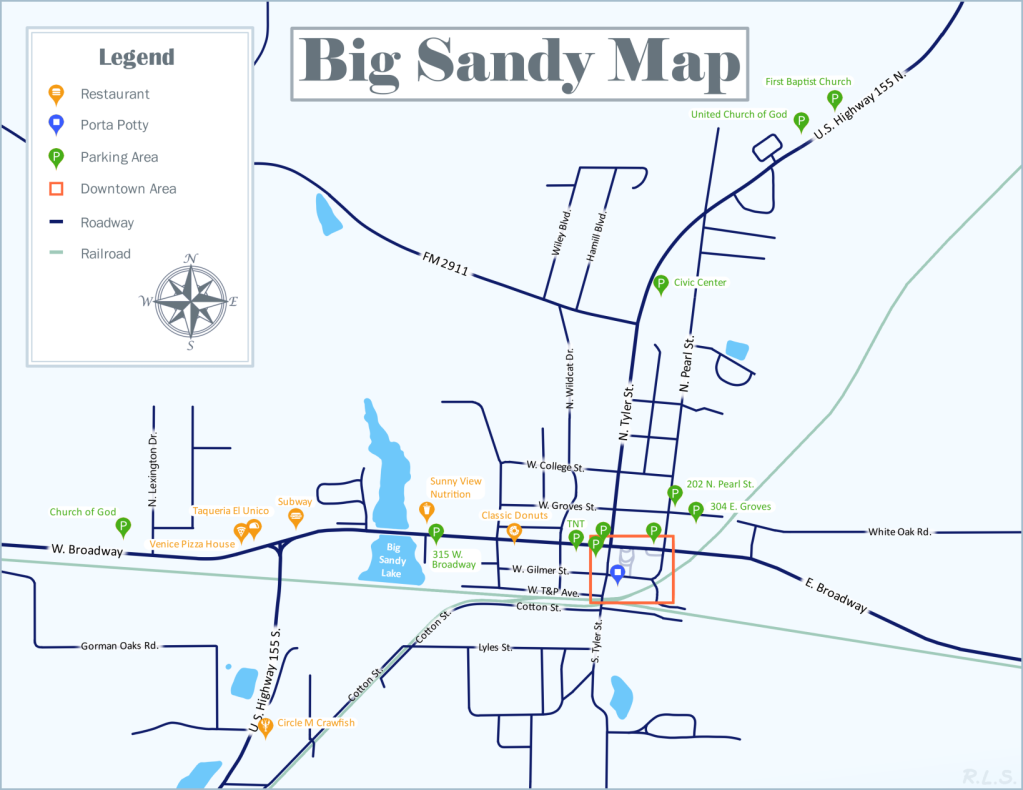Big Boy locomotive’s stop in Big Sandy will be ‘big deal’ for East Texas town
Published 5:40 am Monday, September 16, 2024

- Big Sandy Parking Map With Restaurants.png
BIG SANDY — The name Big Sandy is an oxymoron. It’s a tiny town. But thanks to a big steam engine, it’s a big spot on a big map.
On Tuesday, the largest operating steam engine in the world — the Union Pacific No. 4014, better known as Big Boy — will trundle down the tracks to Big Sandy, an official stop on the engine’s tour across the Union Pacific system. And residents in this Upshur County town are prepared to greet a massive crowd of railroad enthusiasts — better known as “railfans.”
Trending
In terms of tourism, Big Boy’s appearance could be a big break for Big Sandy. The town joins Houston, Fort Worth and Bryan on the railroad’s official map of select locations in Texas where the engine will be on display.
Once upon a time, the arrival of a steam engine in Big Sandy was common. The town’s railroad history is as long as the rail lines that pass through it. But these days, seeing a steam engine is something worth blowing a whistle about.
“This is a very rare event to have a live working steam locomotive come through your town,” said Skip Waters, vice president of trips and events for the National Railway Historical Society’s North Texas chapter. “It’s rare that it’s coming through Big Sandy. … I love the fact that it’s Big Sandy with the Big Boy — the big event.”
Since 2019, Union Pacific has paraded its most beloved engine around the country, attracting thousands of spectators wherever it stops. The engine was built in 1941 to haul heavy freight trains through the Wasatch Mountains in Wyoming, and it ran more than 1 million miles before being retired. It was on static display at a California museum for years before Union Pacific reacquired it and restored it, returning it to the rails for special trips.
This year, as part of the Big Boy’s “Heartland of America” expedition, the engine will leave Texarkana at 9 a.m. Tuesday and travel through Mount Pleasant, Pittsburg and Gilmer. It’ll stop at the Pearl Street Crossing in Big Sandy at 1 p.m. and then highball west to Dallas at 1:45 p.m.
Those 45 minutes in Big Sandy will be something the likes of which the town hasn’t seen — but something its leaders eagerly await.
Trending
At Big Sandy City Hall, colorful maps posted on the glass windows at the front desk show where the engine will park and where spectators can view it. On a recent day, Big Sandy Mayor Linda Baggett held up a thick file folder filled with paperwork used in planning for the event. Town leaders have been moving full steam ahead in preparation for weeks.
But the question is: How will the town accommodate a large crowd? More than 1,000 people are expected.
Local churches have volunteered to let visitors park in their parking lots. At churches that aren’t within walking distance of the Pearl Street crossing, shuttle buses will carry tourists back and forth to the downtown area, where the engine will stop. Tourists will be given cards with information about where they’ve parked, so when it’s time to go, they’ll know which shuttle to take.
Food trucks will be set up one block north of the crossing in a vacant lot between Austin Bank and the post office on U.S. 80.
The Community Center and Welcome Center will be open for people to charge their phones and cool off, and the Big Sandy Museum and downtown businesses will be open.
“This cannot happen with just one person,” Baggett said. “This is a community effort, and everybody’s being so receptive.”
A viewing area for the train will be set up on the south side of East Gilmer Street, which serves as the town’s main road in the downtown district. Spectators are reminded to stay 25 feet back from the tracks for safety reasons.
The ordeal can be seen even by those who can’t attend in-person. A YouTube channel called Virtual Railfan operates live camera feeds at railroad junctions across the nation, including the junction in Big Sandy. The camera will provide prime viewing of the action that day and can be viewed online at tinyurl.com/bigsandycam .
Members of the North Texas Chapter of the National Railway Historical Society will get to town Monday and spend the night at the Heritage Center, which was built for train-watching, and will stay through the train’s arrival Tuesday.
Members of the public can pay an admission fee to enter the Heritage Center on Tuesday, where buttons commemorating the event, DVDs with footage of the Big Boy touring the country and more will be available.
“You don’t want to miss Big Boy, because this is one of those once-in-a lifetime Super Bowl events that this large steam locomotives come through town,” Waters said. “And it’s the only stop in East Texas.”
When the Big Boy arrives, it’ll be pulling historical passenger cars filled with Union Pacific officials and other dignitaries. Railroad officials will designate Big Sandy as “Train Town USA,” an honor the railroad has given more than 130 communities across the country with significant railroad history. Longview, Kilgore, Marshall and Jefferson also have received the designation.
Big Sandy was a vital railway junction in the 20th century between main lines of the St. Louis Southwestern Railway, better known as the Cotton Belt, and the Texas & Pacific Railway. Through various mergers, both lines came under the ownership of the Union Pacific, and rail traffic remains heavy through the town.
The Tyler Tap narrow-gauge railway was the predecessor to the Cotton Belt, and the line later was converted to standard-gauge. (The Big Boy will use the former Cotton Belt line to get to Big Sandy before switching to the former Texas & Pacific line to get to Dallas.)
If it weren’t for the railroad, Big Sandy wouldn’t be what it is today. Literally. When the town was established, its residents moved not once, not twice, but three times to get in close proximity to a rail line.
Mike Baggett, husband of the mayor and a volunteer at the Big Sandy Museum, said the railroads connected Big Sandy to the rest of the country and opened up economic opportunities.
Both of Big Sandy’s railroad depots are as long gone as a fast-moving freight train, but the Big Sandy Museum has photos of the town’s railroading past on display, along with other train-related memorabilia.
“The railroad was such an important part of our history,” Mike Baggett said.






